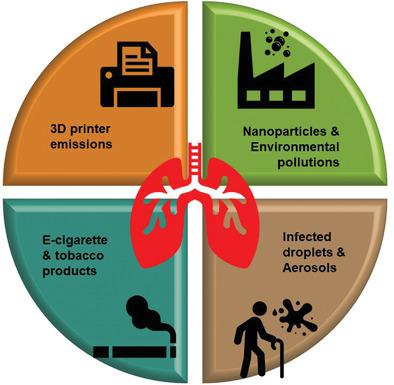当前位置:
X-MOL 学术
›
Adv. Healthcare Mater.
›
论文详情
Our official English website, www.x-mol.net, welcomes your feedback! (Note: you will need to create a separate account there.)
Emerging Technologies for In Vitro Inhalation Toxicology
Advanced Healthcare Materials ( IF 10.0 ) Pub Date : 2021-07-22 , DOI: 10.1002/adhm.202100633 Ajay Vikram Singh 1 , Anthony Romeo 2 , Kassandra Scott 2 , Sandra Wagener 1 , Lars Leibrock 1 , Peter Laux 1 , Andreas Luch 1 , Pranali Kerkar 3 , Shidin Balakrishnan 4 , Sarada Prasad Dakua 4 , Byung-Wook Park 2
Advanced Healthcare Materials ( IF 10.0 ) Pub Date : 2021-07-22 , DOI: 10.1002/adhm.202100633 Ajay Vikram Singh 1 , Anthony Romeo 2 , Kassandra Scott 2 , Sandra Wagener 1 , Lars Leibrock 1 , Peter Laux 1 , Andreas Luch 1 , Pranali Kerkar 3 , Shidin Balakrishnan 4 , Sarada Prasad Dakua 4 , Byung-Wook Park 2
Affiliation

|
Respiratory toxicology remains a major research area in the 21st century since current scenario of airborne viral infection transmission and pollutant inhalation is expected to raise the annual morbidity beyond 2 million. Clinical and epidemiological research connecting human exposure to air contaminants to understand adverse pulmonary health outcomes is, therefore, an immediate subject of human health assessment. Important observations in defining systemic effects of environmental contaminants on inhalation metabolic dysfunction, liver health, and gastrointestinal tract have been well explored with in vivo models. In this review, a framework is provided, a paradigm is established about inhalation toxicity testing in vitro, and a brief overview of breathing Lungs-on-Chip (LoC) as design concepts is given. The optimized bioengineering approaches and microfluidics with their fundamental pros, and cons are presented. There are different strategies that researchers apply to inhalation toxicity studies to assess a variety of inhalable substances and relevant LoC approaches. A case study from published literature and frame arguments about reproducibility as well as in vitro/in vivo correlations are discussed. Finally, the opportunities and challenges in soft robotics, systems inhalation toxicology approach integrating bioengineering, machine learning, and artificial intelligence to address a multitude model for future toxicology are discussed.
中文翻译:

体外吸入毒理学的新兴技术
呼吸毒理学仍然是 21 世纪的一个主要研究领域,因为目前空气中病毒感染传播和污染物吸入的情况预计会使每年的发病率超过 200 万。因此,将人类暴露于空气污染物中以了解不良肺部健康结果的临床和流行病学研究是人类健康评估的直接主题。已使用体内模型充分探索了在定义环境污染物对吸入代谢功能障碍、肝脏健康和胃肠道的系统性影响方面的重要观察结果。在这篇综述中,提供了一个框架,建立了体外吸入毒性测试的范例,并简要概述了作为设计概念的呼吸片上肺 (LoC)。介绍了优化的生物工程方法和微流体及其基本优点和缺点。研究人员将不同的策略应用于吸入毒性研究,以评估各种可吸入物质和相关的 LoC 方法。讨论了来自已发表文献的案例研究和关于再现性以及体外/体内相关性的框架论点。最后,讨论了软机器人、系统吸入毒理学方法结合生物工程、机器学习和人工智能以解决未来毒理学的多种模型的机遇和挑战。研究人员将不同的策略应用于吸入毒性研究,以评估各种可吸入物质和相关的 LoC 方法。讨论了来自已发表文献的案例研究和关于再现性以及体外/体内相关性的框架论点。最后,讨论了软机器人、系统吸入毒理学方法结合生物工程、机器学习和人工智能以解决未来毒理学的多种模型的机遇和挑战。研究人员将不同的策略应用于吸入毒性研究,以评估各种可吸入物质和相关的 LoC 方法。讨论了来自已发表文献的案例研究和关于再现性以及体外/体内相关性的框架论点。最后,讨论了软机器人、系统吸入毒理学方法结合生物工程、机器学习和人工智能以解决未来毒理学的多种模型的机遇和挑战。
更新日期:2021-09-22
中文翻译:

体外吸入毒理学的新兴技术
呼吸毒理学仍然是 21 世纪的一个主要研究领域,因为目前空气中病毒感染传播和污染物吸入的情况预计会使每年的发病率超过 200 万。因此,将人类暴露于空气污染物中以了解不良肺部健康结果的临床和流行病学研究是人类健康评估的直接主题。已使用体内模型充分探索了在定义环境污染物对吸入代谢功能障碍、肝脏健康和胃肠道的系统性影响方面的重要观察结果。在这篇综述中,提供了一个框架,建立了体外吸入毒性测试的范例,并简要概述了作为设计概念的呼吸片上肺 (LoC)。介绍了优化的生物工程方法和微流体及其基本优点和缺点。研究人员将不同的策略应用于吸入毒性研究,以评估各种可吸入物质和相关的 LoC 方法。讨论了来自已发表文献的案例研究和关于再现性以及体外/体内相关性的框架论点。最后,讨论了软机器人、系统吸入毒理学方法结合生物工程、机器学习和人工智能以解决未来毒理学的多种模型的机遇和挑战。研究人员将不同的策略应用于吸入毒性研究,以评估各种可吸入物质和相关的 LoC 方法。讨论了来自已发表文献的案例研究和关于再现性以及体外/体内相关性的框架论点。最后,讨论了软机器人、系统吸入毒理学方法结合生物工程、机器学习和人工智能以解决未来毒理学的多种模型的机遇和挑战。研究人员将不同的策略应用于吸入毒性研究,以评估各种可吸入物质和相关的 LoC 方法。讨论了来自已发表文献的案例研究和关于再现性以及体外/体内相关性的框架论点。最后,讨论了软机器人、系统吸入毒理学方法结合生物工程、机器学习和人工智能以解决未来毒理学的多种模型的机遇和挑战。


























 京公网安备 11010802027423号
京公网安备 11010802027423号